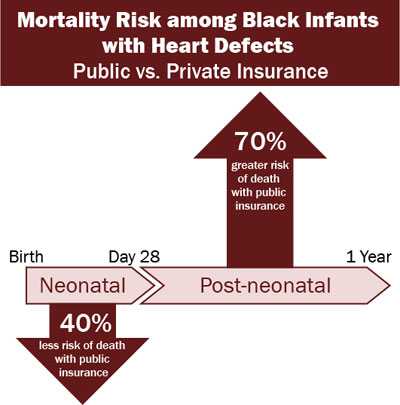Key Findings: Does health insurance impact the survival of babies with heart defects?

A new CDC study published in the American Journal of Public Health looked at the link between health insurance coverage and the survival of a baby born with a heart defect (a congenital heart defect). Researchers found that the type of health insurance coverage was related to the rate of survival among babies born with a heart defect. Health insurance coverage helped explain differences in survival seen between black and white babies born with heart defects. You can read the article’s abstract here.
Main Findings from this Study
- The risk of death was not substantially different between publicly- and privately-insured infants born with a heart defect, except among black infants with a heart defect.

- In the neonatal period, publicly-insured black infants were 40% less likely to die than privately-insured black infants with a heart defect.
In the post-neonatal period, publicly-insured black infants were 70% more likely to die compared to privately-insured black infants with a heart defect. - In the post-neonatal period, babies with heart defects are likely to need follow-up care and continued check-ups with the doctor. Therefore, researchers might be seeing differences in survival during this time period because of factors that affect how well families access healthcare.
- In the neonatal period, publicly-insured black infants were 40% less likely to die than privately-insured black infants with a heart defect.
- Uninsured or underinsured babies born with heart defects were the most vulnerable. This group made up a small number (about 3%) of babies in the study, but infants in this group had a greater risk of death during the first 28 days of life (the neonatal period) compared to infants covered by private insurance.
- Among those with a critical congenital heart defect (severe heart defects that typically require surgery in the first year of life), uninsured babies had three times the risk of death in the first 28 days compared to privately-insured babies.
- Among those with non-critical heart defects, uninsured babies had double the risk of death in the same time period compared to privately-insured babies.
- When researchers took into account the differences in health insurance types [public, private, uninsured/underinsured, or mix (more than 1 type of payer)] between black and white babies, the risk of infant death between black and white babies with heart defects was reduced by 50%, but there was still a difference in survival between black and white infants.
Key Terms
Uninsured or underinsured: These babies either had no insurance (uninsured) or had some health insurance coverage, but not enough to cover all their medical care (underinsured). For this study, both of these types were included in the same category for analysis.
Privately-insured: These babies had health insurance coverage through an employer-based private health insurance company. This health insurance type is usually accessed through a parent’s job.
Publicly-insured: These babies had health insurance coverage through a government program at the federal, state or local level, such as Medicare, Medicaid, or Children’s Health Insurance Program.
About this Study
Researchers used data on babies with congenital heart defects identified by the Florida Birth Defects Registry. These babies were born between 1998 and 2007. Information from hospital stays for these babies during the first year of life was used to examine whether the type of health insurance was related to their survival to one year of age. Researchers also wanted to understand if the type of health insurance coverage was related to the survival of babies with heart defects the same way among different racial and ethnic groups.
More Information
To learn more about congenital heart defects, please visit https://www.cdc.gov/ncbddd/heartdefects/.
Paper Reference
Kucik JE, Cassell CH, Alverson CJ, Donohue P, Tanner JP, Minkovitz CS, Correia J, Burke T, Kirby RS. Role of health insurance on the survival of infants with congenital heart defects. American Journal of Public Health. 2014
Heart Defects: CDC Activities
Centers for Disease Control and Prevention (CDC) works to identify causes of congenital heart defects and ways to prevent them. We do this through:
- Surveillance or disease tracking:
- State programs: CDC funds and coordinates the Metropolitan Atlanta Congenital Defects Program (MACDP). CDC also funds 14 population-based state tracking programs. Birth defects tracking systems are vital to help us find out where and when birth defects occur and whom they affect.
- Adolescents and adults: CDC recently funded 3 projects to track congenital heart defects among adolescents and adults in order to learn about their health issues and needs across the lifespan.
- Research: CDC funds the Centers for Birth Defects Research and Prevention, which collaborate on large studies such as the National Birth Defects Prevention Study (births 1997-2011) and the Birth Defects Study To Evaluate Pregnancy exposureS (to start with births in 2014). These studies work to identify factors that increase the risk for birth defects, including heart defects.
- Collaboration: CDC provides technical assistance to the Congenital Heart Public Health Consortium, a unique collaboration that brings together families, experts, and organizations to address congenital heart defects.
- Page last reviewed: May 18, 2016
- Page last updated: May 18, 2016
- Content source:


 ShareCompartir
ShareCompartir